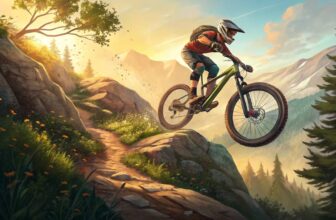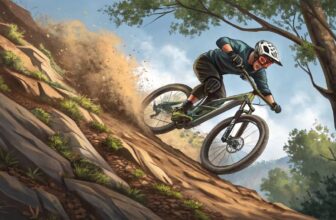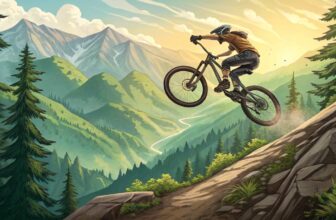Understanding Tire Pressure Basics
Why Tire Pressure Makes or Breaks the Ride
Getting tire pressure right is like finding that sweet spot in a mountain biking adventure. Nailing it means you’ve got a good grip, a comfy ride, and your bike’s doing its best job. It’s like magic: the grip feels stronger, the ride gets smoother, and you’re less likely to deal with pesky punctures when tire pressure’s on point.
Following the recommended tire pressure isn’t just a suggestion—it’s a must. It’s sorta like the rulebook for taking on all sorts of trails without a hitch. Mess up the pressure, and you’re looking at bad handling, worn-out tires, or even a flat tire mess-up.
| Tire Pressure Perks | What’s the Deal? |
|---|---|
| Better Grip | Your bike hugs the trail tightly |
| More Comfort | Feels less bumpy over rough paths |
| Fewer Flats | Keeps those dreaded flats at bay |
| Top-Notch Performance | Mixes steady rides with speed boosts |
Rookies! Fear not. A good start is finding a middle-of-the-road pressure and tweaking as you and the trail get to know each other better. Check out our chat on mtb suspension setup if you want the scoop on personalizing your ride.
Stuff That Plays with Tire Pressure
There’s a bunch of stuff that messes with how you should set up your tire pressure for hitting those trails. Let’s talk:
1. What is Weighing?
Your heft can twist this pressure thing up a bit. If you’re packing some weight, crank it up a notch to keep things rolling smoothly. On the other hand, being on the lighter side lets you drop the pressure a tad, sipping on better grip and cushy feels.
2. Nature of the Beaten Path:
Different paths want different pressure vibes. For those gnarly rock-stuffed trails, less pressure helps with grip and bounce. But when you’re zooming down smooth trails, a bit of extra pressure pushes you faster and eases the roll.
3. Tire Talk:
Not all tires are the same breed. Some tires are all flexible and light, making for a silkier ride. Others are tougher, ready to face any puncture drama. Picking the right tire for how you like to ride can shake up the fun meter.
4. So… What’s the Weather?
Yeah, the sky matters here too. Wet outside? Lower that pressure a tad for more tire-to-ground grip. But under the sun? Pump it up to keep that zippy speed in check.
5. Your Tire Game:
Are tubeless tires your jam, or are you holding on to tubes? Tubeless folks usually keep it low for an all-around grip and fewer flats. If you’re into the tubeless world, get your setup swagger on at tubeless mtb setup.
| What Affects Pressure | How It Messes With Tire Pressure |
|---|---|
| Rider’s Heft | More weight needs more pressure |
| Trail Type | Rocky = lower, Smooth = pump it up |
| Tire Choice | Hi-flex: Drop it; Stiff: Hike it up |
| Weather Call | Wet = drop it; Dry = boost it |
| Tire Setup | Tubeless = keep it low |
Knowing this can keep you from getting into pressure trouble and help make the most of your ride. Keep a trusty pressure gauge handy and keep things steady. Want more wisdom? Peek into our bit on mtb tire compounds.
Tire Pressure for Different Riding Styles
Mountain biking’s got its flavors, and each demands its own tire mojo. Get the lowdown on tire pressures for Cross-Country (XC) riding, Trail Riding, Enduro, and Downhill adventures.
Cross-Country (XC) Riding
XC is the speedster of mountain biking, zooming along hard trails while making climbs look easy. Tire pressure here is the unsung hero keeping you moving slick and steady.
| Terrain Type | Recommended Pressure (PSI) |
|---|---|
| Hard Pack | 30 – 35 |
| Light Technical | 28 – 32 |
| Climbing | 32 – 35 |
For lighter folks (under 150 pounds), dialing back the pressure helps grip and smoothness. Heavier friends (over 200 pounds), crank it up a notch to dodge tire squish and glide with ease. Check out mountain bike body position to upgrade your XC game.
Trail Riding Techniques
Trail riding is like a playground of rocks, roots, and all things bumpy. Tweak that pressure for just the right cocktail of grip and bounce.
| Terrain Type | Recommended Pressure (PSI) |
|---|---|
| Mixed Terrain | 25 – 30 |
| Rocky Sections | 27 – 32 |
| Rooty Trails | 23 – 28 |
Play around with these numbers till you find that magic spot balancing grip and glide. For extra tips, scope out MTB tire compounds for the perfect match.
Enduro Riding Considerations
With Enduro, it’s all about bouncing off rocks and roots while taming steep drops—the wild west of biking. Perfect pressure means nailing performance and comfort.
| Terrain Type | Recommended Pressure (PSI) |
|---|---|
| Steep Descents | 23 – 27 |
| Technical Obstacles | 24 – 29 |
| Rocks and Roots | 22 – 26 |
Drop those pressures a bit to cling to those gnarly trails but keep an ear to the ground for changes. Peek at mtb gear indexing to supercharge your setup.
Downhill (DH) Riding Specifics
Downhill might as well be called controlled chaos. Tackle hair-raising descents, rocket over jumps, and breeze through rock gardens. Tire pressure is your best buddy here.
| Terrain Type | Recommended Pressure (PSI) |
|---|---|
| Steep Descents | 23 – 28 |
| Rock Gardens | 24 – 30 |
| High-Speed Sections | 25 – 32 |
For DH, the trick’s in the sweet spot—high enough to avoid dings, low enough for those tight grips. Get your speed mojo going with mountain bike brakes.
Whatever your riding style, a trusty tire gauge is your sidekick, inching towards perfection one PSI at a time. Dive deeper into advanced tire pressure insights to polish your performance.
Ideal Tire Pressure Guidelines
Lighter vs. Heavier Rider Considerations
How much you weigh makes a big difference in finding the sweet spot for mountain bike tire pressure. Heavier folks gotta crank that pressure up to keep everything balanced when they’re tearing down trails because gravity’s not taking it easy on them. Meanwhile, those who weigh less can afford to let a little air out for extra grip and control.
- Heavier Riders: If you’re tipping the scales at over 176 lbs (80 kg), think about pumping those front/rear tires to 30/32 PSI.
- Lighter Riders: Lighter than that? You’ve got the luxury of softer tires, which could mean a smoother, stickier ride.
| Rider Weight | Front Tire Pressure (PSI) | Rear Tire Pressure (PSI) |
|---|---|---|
| Under 70 kg | 18 – 22 | 20 – 24 |
| 70 – 80 kg | 22 – 26 | 24 – 28 |
| Over 80 kg | 28 – 30 | 30 – 32 |
Wet vs. Dry Trail Pressure Adjustments
The weather throws its hat in the ring when it comes to tire pressure, too. Slick, wet, or muddy trails? You’ll want lower pressures to keep from skating right off-course. On a dry day, crank it up a bit to slice through the hardpack with speed and efficiency.
- Wet/Muddy Trails: Keeping pressure low gives you a grippier ride on slippery stuff.
- Dry/Hardpack Trails: A bit more pressure translates to less drag and quicker times.
| Trail Condition | Front Tire Pressure (PSI) | Rear Tire Pressure (PSI) |
|---|---|---|
| Wet/Muddy | 18 – 20 | 20 – 22 |
| Dry/Hardpack | 24 – 26 | 26 – 28 |
Tubeless vs. Tubed Tire Pressures
Whether you’re riding tubeless or sticking to tubes tricks up the pressure game, too. Tubeless setups allow for softer rolling without worrying about pinch flats, making for a ride that’s stickier and comfier. With tubes, you’ll need a bit more pressure to keep everything in line—though you might give up some grip.
- Tubeless Tires: Softer setup for enhanced grip and comfort.
- Tubed Tires: More air helps avoid those troublesome pinch flats.
| Tire Setup | Front Tire Pressure (PSI) | Rear Tire Pressure (PSI) |
|---|---|---|
| Tubeless | 18 – 22 | 20 – 24 |
| Tubed | 24 – 26 | 26 – 28 |
Playing around with these pressure guidelines lets you dial in what feels right and gets the most out of your bike. Get the tire setup just right, and your ride becomes smoother, faster, and more adventurous. If you’d like to learn more about gearing up for better rides, check out our articles on mtb suspension setup and mountain biking basic skills for additional tips!
Fine-Tuning Tire Pressure
Getting your mountain bike tire pressure just right can make your rides smoother, boost your grip, and up your game overall. Here’s the lowdown on giving your tires the best fit for your style.
Figuring Out Pressure Sweet Spots
Sorting out the best tire pressure needs some trial and error. It changes with how you ride, how much you weigh, and what kind of trails you hit. For example, lighter folks can roll with lower pressures, while those on the heavier side might need a bit more air.
Start with a baseline and tweak it in small steps based on your ride:
| Rider Weight | Baseline Pressure (PSI) |
|---|---|
| < 140 lbs | 17-20 |
| 140-180 lbs | 20-23 |
| > 180 lbs | 23-25 |
How You Ride and Where You Ride
Your stance on the bike and the terrain under your wheels make a big difference in what pressure’s best. If you’re cruising on smooth trails, harder tires help you zip along with less effort. But tougher, rockier paths call for softer tires for better grip and a cushier ride—just don’t go too soft or you’ll risk dinging your rims and feeling wobbly.
The Essential Tire Pressure Gauge
For pinpoint pressure tweaks, you need a trusty gauge. Check your tire pressure often to keep your rides consistent and your tires lasting longer.
| Pressure Gauge Type | Features |
|---|---|
| Analog Gauge | Basic, long-lasting, not super exact |
| Digital Gauge | Precisely accurate, easy to read, needs batteries |
Regularly jot down your pressures and performance notes, especially with changing trail conditions, to find your ultimate tire setup. For more tweaks on gearing up your bike, peek at our pages on mountain bike sizing and MTB suspension setup.
Keeping your tire pressure on point can seriously upgrade your biking fun. Test out different settings and gear, and always think about the trail and the day’s weather before you set off. For extra tips on mountain biking essentials and skills, dive into our blog.
Advanced Tire Pressure Insights
Dialing in the perfect mountain bike (MTB) tire pressure isn’t just about guessing and going—it’s about knowing your stuff. The magic happens when you get into tire compounds, casing, and smart testing. Let’s break it down so you can hit the trails without a hitch.
Tire Compound and TPI Factors
Think of tire compounds and TPI (threads per inch) as the DNA of your tires. They’re big players in setting that sweet tire pressure spot. Higher TPI? It’s all about being light and flexible—your ride will feel smoother than a supermodel on a catwalk, with a grip that sticks like glue. Lower TPI, though, gives you some beef—those bad boys are stiff and tough, ready to rock on gnarly tracks without flinching.
| TPI Range | Characteristics | Ideal Usage |
|---|---|---|
| 60 – 120 | Light, flexible, good grip | XC, Trail |
| 30 – 60 | Stiff, puncture-resistant | Enduro, DH |
So, if your TPI is on the high side, you can sneak in a bit less pressure for extra grip, without turning your bike into a wobbly mess. Check out our deep dive into MTB tire compounds for the nitty-gritty.
Tire Casing and Rim Setups
The casing and how your rims are set up is like a backstage crew—do things right, and your tires will roll better. Hardcore casings, like MAXXIS DoubleDown or Schwalbe Super Gravity, let you run low without playing rim roulette (nod to ENDURO Mountainbike Magazine). Tubeless setups are the jackpot here, letting you glide lower, ducking those nightmare snakebite punctures you’d get with tubes.
| Casing Type | Pressure Range | Best Used For |
|---|---|---|
| Lightweight | Higher pressure | XC, Trail |
| Heavy-Duty | Lower pressure | Enduro, DH |
A solid rim setup helps, giving you that plushy ride and awesome traction. Get the know-how on setting up tubeless with our tubeless MTB setup.
Optimal Tire Pressure Testing Methods
Ready to find your tire pressure nirvana? It’s go-time with some field testing. Start high, ease down till you hit the Goldilocks zone—where grip, protection, and stability dance in harmony. Real-world testing by feeling your ride shift beneath different conditions is how the pros do it, as suggested by ENDURO Mountainbike Magazine.
Steps to Test Optimal Tire Pressure:
- Start High: Begin with the pressure cranked up. You don’t need drama with rim dings.
- Gradual Reduction: Slowly drop it, jotting down how your ride turns out.
- Field Conditions: Explore mixed terrains like a mad scientist scrutinizing the results.
- Fine-Tuning: Tweak it to its perfection, sweet grip, and rock-solid steadiness.
Grab some more intel on perfecting tire pressure with our MTB suspension setup.
Grasp these tire pressure secrets, and you’ll ride like you own every trail. Go ahead, get those wheels whirring, and make the most of your MTB adventures!




